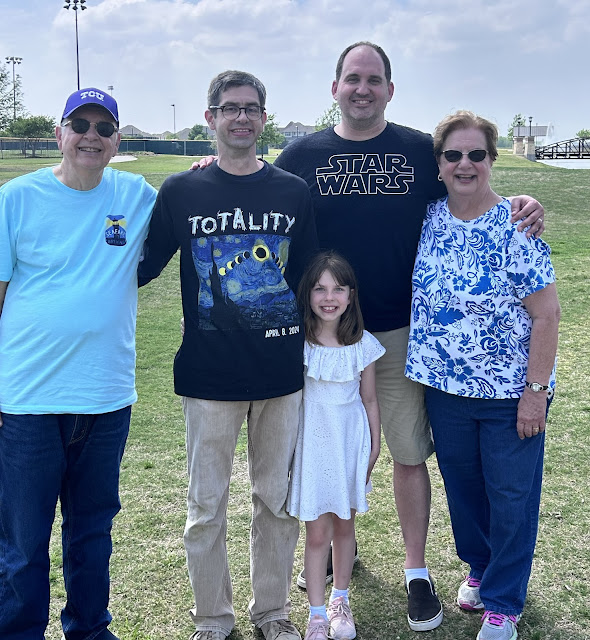Long Range Cloud Escaping
This post covers a very important subject that I suggest that all who visit the totality path think about: what would you do if the forecast calls for cloudy skies at eclipse time in the area that you're wanting to view it, and significantly clearer skies somewhere else?
I will be posting some links later that are useful for reviewing weather forecasts and updates. It helps you learn how to take a deeper dive and look at the various weather models.
Note that, just because the forecast calls for clouds doesn't mean that you should necessarily leave and drive to clearer skies. Certain types of clouds may dissipate, or going to clearer skies may be too far.
Also, the websites I will feature list cloud coverage in percentage. 50% cloud cover could mean that half the sky is clear, and the other half overcast- or it could mean that the clouds are scattered in all directions and overhead, but the total percentage of sky coverage is 50% (meaning: large patches of blue in between). More on that on another post.
Also remember: you're concerned with the part of the sky where the sun is. 30% cloud coverage seems good, unless that very 30% of the sky covered by clouds is right in the direction of the sun.
But let's assume that- at least for this scenario- we're talking about a situation where the forecasts are calling for very heavy clouds covering the sun where you are planning to be, and clear skies somewhere else in the path of totality.
Many people, when faced with this scenario, will ask "How far do we want to go?"
My concern with that is that it puts emotion into the answer. I've seen some people online saying "I'm going to drive all night to escape from the clouds if necessary!" I get it. The eclipse is amazing. But driving all night could be unsafe, leading to fatigue. Perhaps there are relief drivers, multiple breaks, and so on. But still, we should not be putting our desire to see the eclipse over our own safety or the safety of others.
On the other hand, there are some people that will say "I don't really want to go anywhere. I'm not that much into this eclipse."
But imagine a scenario in which a weather system was moving through at eclipse time. The clearing line is 20 miles away. Would you drive 20 miles to get out from under the clouds? I am hoping that many people would realize the rarity (and the spectacular nature) of the event, and at least make a short drive like that, should a similar scenario present itself.
But what about 50 miles? 100? That is why, in my opinion, the first question to be asked should rather be "How far CAN we go?"
"How far CAN we go" puts a limit on the distance, based solely on safety and practicality. Even if you wanted to go farther than it was safely possible for you, it's best that you keep it within that distance.
Please note: I understand that many people may not be able to go anywhere. They may have other commitments such as work, or may a bit older, or other reasons.
This is mainly for people who do have the capability of driving at least a short distance, but are saying that they are going to stay. The hope is to get them to consider driving at least some distance to escape from heavy clouds.
So how can we figure out how far you and your group could go? I'll use my experience in eclipses to tell you: as long as you're able to get enough sleep the night before; as long as you are able to eat sufficient meals during the day; as long as the length of the drive does not exceed what you and your group can handle; and as long as you are able to make it to your destination (perhaps back home) by a reasonable hour at the end of the day, the drive to get into clear skies (staying in the totality path) WILL. BE. WORTH. IT. Do you need inspiration? Read the stories and watch the videos on my earlier posts on this blog.
That being said, once you've figured out the limit of how far you CAN go to escape from heavy clouds, THEN you can ask the question of how far do you WANT to go? Ideally, the distance you choose should lean heavily towards how far you CAN go. But if you don't want to go that far, then perhaps compromise and split the difference.
Overall, the goal is simply to start the conversation.
One tricky thing to figure out: I've been talking in a time scenario- what about distance? Normally, using highway speeds, 3 hours (for example) would get you about 200 miles or so. But traffic may have it be less than that. Please note that the heaviest traffic will be going back to major cities, especially if the city itself had heavy cloud cover. Roads and highways going back to cities outside of, but rather close to, the totality path will also have the heaviest traffic.
Most important: if you do travel to escape the clouds, then STAY WITHIN THE ZONE OF TOTALITY. All you need is just that one hole in the clouds at just the right time.
Next up: short range cloud escaping.
Thanks for reading this!

Comments
Post a Comment